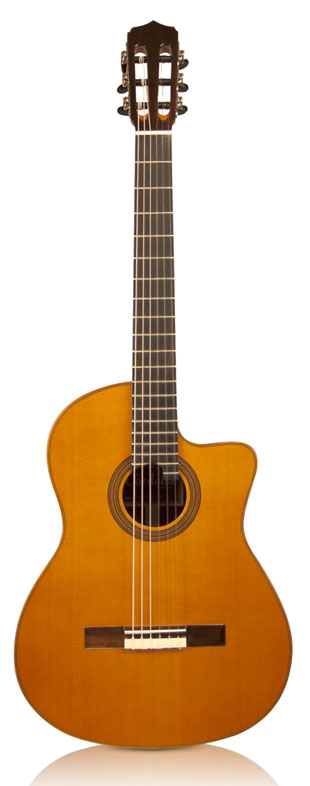Nylon-String Guitar Tips for Steel-String Players

The nylon-string guitar is, of course, essential when it comes to traditional classical and flamenco playing, and it is also the instrument of choice in many forms of Latin music. But many jazz, rock and pop guitarists also praise the nylon-string for its unique tone, which simply cannot be produced on a steel-string. Charlie Byrd in jazz, Earl Klugh in easy-listening pop and Willie Nelson in country are all nylon-string men.
The nylon sound manages to be sweet, fat and brilliant, all at once. There is a fat quality to the treble strings on a nylon-string acoustic that can not be produced on a steel-string model, while at the same time the bass strings can often produce a richer, deeper fundamental note than those on a steel string. Why? A good part of the answer lies in the fact that nylon strings exert much less tension than do steel strings. As a result, the guitar can be made of thinner and more lightly braced woods, which therefore vibrate more easily than those commonly used in steel-string construction. A side benefit of this is that it’s possible to find many lively and responsive nylon-strung guitars at reasonable prices.
When serious classical guitarists lay down big bucks for a guitar, the qualities they look for are clarity, bell-like beauty of tone, enough volume to fill a small hall without amplification, overall sustain and a strong and singing third (G) string. Classical guitarists prefer the tone of solid rosewood backs and sides, unlike their flamenco counterparts, who go for the sharper, more piercing sound associated with cypress, maple or sycamore. And classical guitarists often prefer a high action that lets them really dig into the string without buzzing, while flamenquistas, as they are known, like a low action that is conductive to slapping the strings.
Fortunately, the requirements of rock and pop guitarists seeking to add the sound of nylon strings to their tonal arsenal are less exacting than those of their classical and flamenco brothers. Volume, one of the main considerations classical/flamenco people must contend with in choosing a guitar, is not as essential with rock players, who are not appalled by the very notion of amplification.
While accomplished classical guitarists typically expect to pay thousands of dollars for a suitable instrument, the steel-string player looking for that nylon vibe can do quite nicely with a relatively inexpensive —say $300 to $700—model. As a matter of fact, high-end nylon-string models, with their deep, dark and fat tones, often do not blend well with band instruments, a deficiency many steel-stringers would find unacceptable.

Sounds good, right? You’re home free...almost. There’s still that pesky third string to consider. The fact is, the extensive work that makes it possible for an ordinary gauge third string to sing is the thing that makes a great classical guitar great - and expensive. But despair not. Simply use a wound or high-tension third string on your moderately priced nylon. You’ll have to sacrifice some of that fabulous high-end lyricism, but in return you’ll still be able to obtain reasonable string balance, and for a fraction of the cost. Incidentally, you’ll also find that ordinary consumer-market nylon-strings guitars don’t usually feature the rather high action preferred by concertizing classical guitarists. But this won’t, or should not, disturb you.
So here, at long last, are my considered words of wisdom: When checking out nylon-string guitars, confine yourself to the $300 to $700 street-price range (or even less, if you can find a good used instrument). Doing so means that you’ll be looking at guitars with either laminate or solid tops, but certainly laminate bodies.
All the latest guitar news, interviews, lessons, reviews, deals and more, direct to your inbox!
Look for an instrument that has a built-in pickup and a preamp with tone controls. By the way, here’s a tip: Steel-string guitars usually need to go through a console or special acoustic guitar amp to sound acoustically true. Nylon-string guitars, though, often sound quite good played through an electric guitar amp.
You’ll probably notice some improved tone and sustain, and sophistication of the electronics, as you check out nylon-string models at the $700 level. But you may also find that the difference is not so great as to justify the higher price. So by all means use your ears, keep your mind open and don’t jump to conclusions based on the price tag alone. Finally if you’re used to playing on the higher frets, look for a model with a cutaway.
There are a number of acceptable to very good nylon-string guitars on the market in that $300 to $700 price range that would suit nonclassical players looking for something different. There are, of course, exquisite, handmade model prices. But it is possible to get a nice instrument at a nice price.
